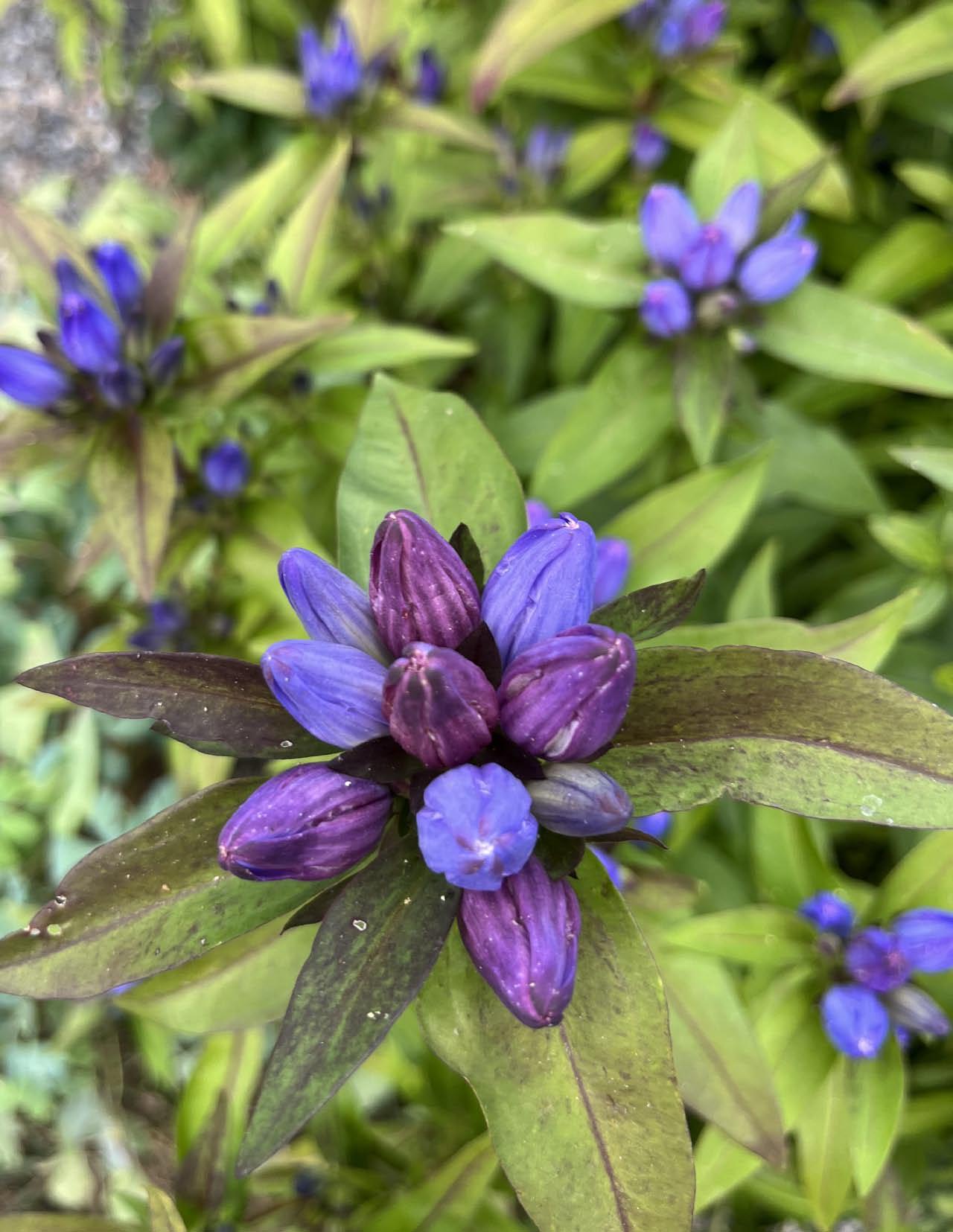

WASHINGTON g a rdener
the magazine for gardening enthusiasts in the Mid-Atlantic region
There is Always Room for Air Plants
Dealing with Burdock
A Visit to UMD’s Dessie M. Moxley Gardens
“Leaf” Your Lawn Unraked This Fall Treehoppers on Your RedBud Tree
Daffodil
Planting Tips
Garden Book Reviews and Reader Contest
Meet the Crazy 4 Dahlias Garden
Native Nodding Ladies’ Tresses
Growing Rhubarb
New ‘Rock Candy’ Sedum





Your Ad Here

Are you trying to reach thousands of gardeners in the greater DC region/Mid-Atlantic area? Washington Gardener Magazine goes out on the 15th of every month. Contact KathyJentz@gmail.com or call 301.588-6894 for ad rates (starting from $200) The ad deadline is the 10th of each month. Please submit your ad directly to: KathyJentz@gmail.com

Need a Garden Club Speaker?
Washington Gardener Magazine’s staff and writers are available to speak to groups and garden clubs in the DC region and ONLINE! Call 240.603.1461 or email KathyJentz@gmail.com for available dates, rates, and topics.

RARE AND EXCEPTIONAL PLANTS FOR THE
Barry Glick
Sunshine Farm and Gardens 696 Glicks Road Renick, WV 24966, USA Email: barry@sunfarm.com www.sunfarm.com

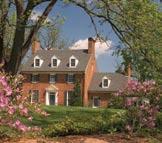
www.greenspring.org
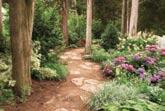
Green Spring Gardens
A “must visit” for everyone in the metropolitan Washington, DC, area. It’s a year-round goldmine of information and inspiration for the home gardener. It’s an outdoor classroom for children and their families to learn about plants and wildlife. It’s also a museum, a national historic site that offers glimpses into a long, rich history with colonial origins. Located at 4603 Green Spring Rd., Alexandria, VA. Information: 703-642-5173.
Nodding

Crazy 4 Dahlias in Damascus, MD, is owned and operated by John Spangenberg. Photo by Alan Fisher, courtesy of www. crazy4dahlias.com.

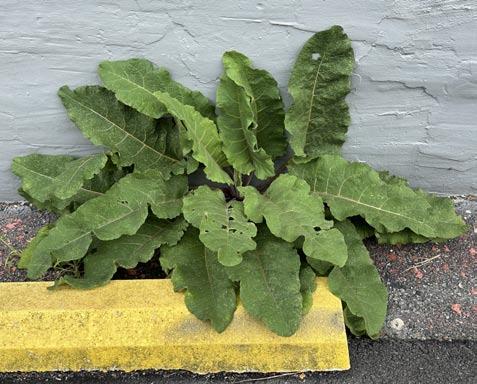


Saying “No” to Artificial Intelligence
The advent of artificial intelligence (AI) has created a flood of gardening content and articles online that are trained on everyone’s work without regard to consent, copyright, or compensation. Worse still, they are pulling from various online sources that may be outside our region, but presenting it as tailored to appear from your ZIP code. Many times, there are gaps in the provided information, so AI just makes up content to fill that in and even makes up fake sources for those “facts.”
Then there are the AI-generated images and videos. Some are obvious fakes with hostas in unworldly hues or roses with strange foliage, but others are landscapes that combine enough real elements to fool many viewers. The most upsetting are those that use the images or voices of real people in unreal ways. For instance., YouTube has offered to translate my videos and have me speak in fluent French or Mandarin (languages I have never spoken). No thanks.
Even the plant identification applications (plant ID apps) that rely on AI have to be double-checked. They can assist in getting you in the ballpark, but you still need to find actual images of the plant in question to make a positive identification.
I’m proud to say that Washington Gardener Magazine, our GardenDC Podcast, and our YouTube videos are the products of real humans and not AI. We do things the old-fashioned way, meaning we grow the plants we write about and if we take photos and videos in a garden, we show it all—weeds and insect-bitten leaves included.
Sincerely,

Kathy Jentz, Editor/Publisher, Washington Gardener, KathyJentz@gmail.com
Credits
Kathy
Jentz Editor/Publisher
Washington Gardener 826 Philadelphia Ave. Silver Spring, MD 20910
Phone: 301-588-6894
kathyjentz@gmail.com www.washingtongardener.com
Ruth E. Thaler-Carter Proofreader
Cavit Ireland
Ellen Isaacson Interns
Subscription: $20.00
• Washington Gardener Blog: www.washingtongardener.blogspot.com
• Washington Gardener Archives: http://issuu.com/washingtongardener
• Washington Gardener Discussion Group: https://groups.google.com/g/ washingtongardener/
• Washington Gardener Twitter Feed: www.twitter.com/WDCGardener
• Washington Gardener Instagram: www.instagram.com/wdcgardener
• Washington Gardener Facebook Page: https://www.facebook.com/ WashingtonGardenerMagazine/
• Washington Gardener YouTube: www.youtube.com/ washingtongardenermagazine
• Washington Gardener Amazon Store: www.amazon.com/shop/wdcgardener
• Washington Gardener BookShop: bookshop.org/shop/WDCgardener
• Washington Gardener Podcast: https://podcasters.spotify.com/pod/ show/gardendc/
• Washington Gardener Plant Store: https://shop.kathyjentz.com/
• Washington Gardener is a woman-owned business We are proud to be members of:
· GardenComm (formerly GWA: The Association for Garden Communicators)
· Green America Business Network
· National Garden Bureau
· One Montgomery Green
· Ladies in the Landscape
· Potomac Rose Society
· American Horticultural Society
· Maryland Nursery, Landscape and Greenhouse Association
Volume 20, Number 8
ISSN 1555-8959
© 2025 Washington Gardener
All rights reserved. Published monthly. No material may be reproduced without prior written permission. This magazine is purchased by the buyer with the understanding that the information presented is from various sources from which there can be no warranty or responsibility by the publisher as to legality, completeness, or technical accuracy.
Your editor and garden writer Teri Speight at the AHS Gala at River Farm, Alexandria, VA.
What an absolute delight to see Autumn Daffodil (Sternbergia lutea) get some prominence in the October 2025 issue. I purchased a dozen bulbs about five years ago, lured by the vendor’s promotional message touting the plant’s versatility and capacity to survive in bright and arid situations. As a bonus. it was presented equally as rewarding in semi-shade environments. Right on both counts! The flower and new growth appeared simultaneously in midSeptember. We get about a three-week flowering presentation in both full-sun and semi-shade. There is a modest green clump of green growth that lasts through June the following year, when this cultivar goes dormant until the fall blooming cycle. It naturalizes beautifully—especially in the semi-shade environment. Its adaptability in full sun and arid situations makes this a splendid option for the difficult driveway
Your Ad Here
situations. Despite the road salts and generous pet discharges, this cultivar marches on. I found dividing this plant seemed happiest when accomplished as the seasonal growth fades in June. Flowers appear right on schedule in mid-September.
Bulbs sent from the vendor for fall planting seem to take a full two years to get their bearings. Bambi and his ilk are not attracted to the new growth or flowers.
~ Joe Francis, Herndon, VA
I really enjoy the magazine and I learn something from each edition. The articles on Waxwings and “How to Choose and Care for Fall Mums” were interesting, but my favorite piece has to be Miguel Zarate’s “Learning While Growing Tomatoes.” I’ve had the same issues with my own tomatoes in the past (blight, rampant growth), even needing to stop yarrow from taking
Are you trying to reach thousands of gardeners in the greater DC region/MidAtlantic area? Washington Gardener Magazine goes out in the middle of every month. Contact KathyJentz@gmail.com or call 301.588.6894 for ad rates (starting from $200). The ad deadline is the 5th of each month. Please submit your ad directly to: KathyJentz@gmail.com.

Plant a Row for the Hungry (PAR) is an easy program to participate in and really does not take any extra resources than what you may have in your garden. In normal times, about 35 million people wonder where their next meal will come from. Most of these are children. That’s where PAR steps in.
PAR is such a simple program: It urges gardeners to Plant A Row (or a container) dedicated to feeding the hungry, and then take the harvest to someplace or someone that needs it. Once you have donated, send an email to KathyJentz@gmail.com with the total (in pounds and ounces) of what you gave. That is all there is to it. Easy. Effective. Adaptable and Helpful.
over, (and I’ve never won a ribbon for my ‘Sun Gold’). His piece brought back memories of being a “new” gardener, and how there is nothing quite so rewarding as growing a tomato. What I loved was the gardening journey, Miguel’s and that of your other interns, that I have followed from their arrival. The ups and downs of crop successes and failures, wrapped up in a journey of discovery and community, seeding, if you will, a deeper understanding of and connection with life through gardening.
~ Luann Korona, Silver Spring, MD
My favorite article in the July/August 2025 issue was “Grow a Bee-friendly Lawn.” It came at just the right time, as the grass in my yard looks quite tired and dry, and soon it is time to work on lawn renewal. I try each year to make the remaining grassy areas of lawn more eco-friendly. Years ago, I made my peace with clover and wild strawberry, but I have never tried purposely seeding clover into the grass, so I followed the advice in the article and ordered some miniclover from Outsidepride. I’ll watch over the next year to see how it goes.
~ John Rebstock, Cheverly, MD
I loved your informative Stevia article in the May 2025 issue. I’m a Type 2 diabetic and I adore growing the white flowers with light-purple/lavender accents as well as its taste and solution as a sugar substitute. Learning more about Stevia’s history, what it does as a natural plant, along with its 1,500-years history beginning with the indigenous Guarani people, backs up how supernatural it is.
It’s definitely the real thing—no chemicals like all the other sweeteners. Plus, the history, commercialization, and growing tips absolutely make it a “super plant” and more than satisfy my curiosity and inquisitiveness. It’s been in my herb garden for more than 10 years.
~ Melinda Sue Sigal
Just took up water gardening. Some goldfish, too. Happy I found this “Water Gardening and Koi Ponds” episode of the GardenDC Podcast. Loved every minute.
~ BlackHeart o
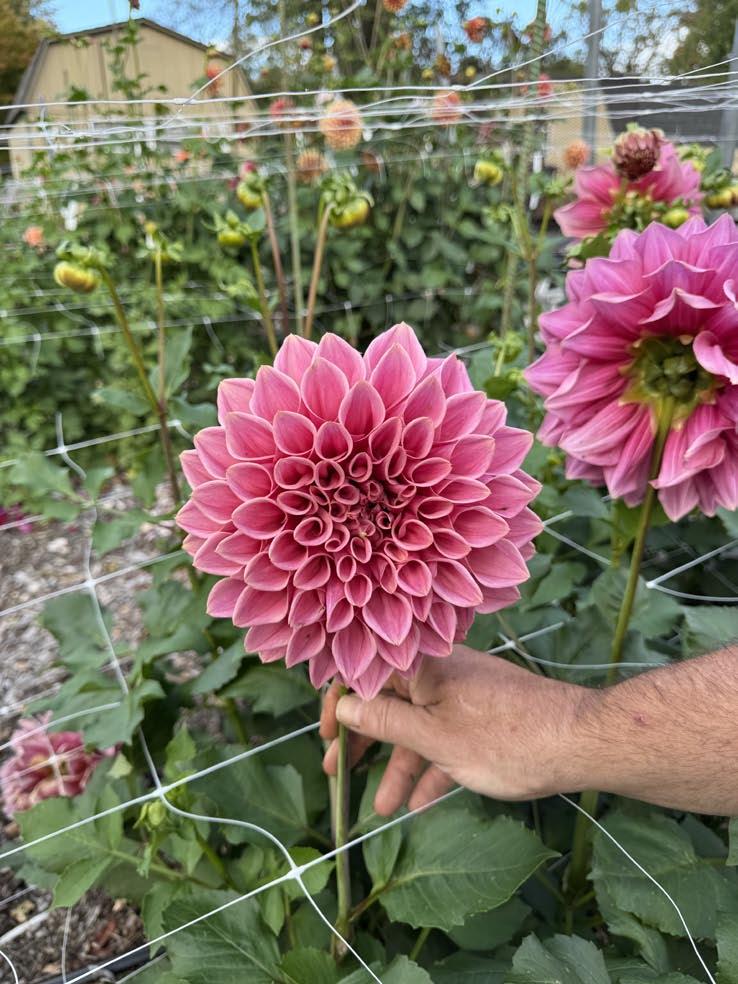
Crazy 4 Dahlias Garden John Spangenberg
Dahlias have been a part of John Spangenberg’s life since his grandfather first started growing them in Takoma Park, MD, long before John’s time; he later moved his garden to Damascus, MD. John has continued that family legacy.
On a mild, mid-October day, Spangenberg showed me around his lush dahlia garden, Crazy 4 Dahlias, in Damascus, MD. I was first intro-
duced to him at the recent National Capital Dahlia Society’s 90th Annual Dahlia Show at Brookside Gardens in Wheaton, MD. John is a member of the society and had many different breeds and varieties on display at the show. He is the director of the Mid-Atlantic Trial Garden, as well as a senior judge and a member of the Classification Committee of the American Dahlia Society.
When I first arrived at the Crazy 4 garden, I was greeted by the charming and colorful flower stand out front that read “DAHLIAS” in bright scarlet-red letters. On the homemade stand made by Spangenberg and his wife, rested six vibrant bundles of dahlias, their colors arranged in a stunning progression, from cheerful yellow on the left to deep, velvety red on the right. Customers are welcome to come and pick their own dahlia flowers by making a small cash contribution or via Venmo.
Spangenberg is a hybridizer and specializes in growing both show and garden dahlias. A hybridizer is someone who cross-pollinates plants to create new varieties with unique colors, shapes, or improved growing traits. Spangenberg currently grows dahlias for four different clients and his business is steadily growing—and the best part is that his clients are friends of his who share his passion.
Spangenberg helps with the logistics of these hybrid plants and getting his clients, new blooms out into the world. The Crazy 4 Dahlias garden grows around 800 dahlias each year—95% of which are show dahlias. Spangenberg explained that the criteria judges consider when judging dahlias at shows, like the recent one at Brookside Gardens.
The American Dahlia Society sponsors many different trial gardens. Trial gardens are where hybridizers send their flowers to be judged to see if they would compete well with in the American Dahlia Society show standards.
Spangenberg showed me some of the blooms he would consider to be show dahlias. He emphasized that judges are looking for a symmetrical, round shape with uniform and evenly spaced petals. While show dahlias steal the spotlight with their flawless form, Spangenberg finds beauty in all blooms, even the less-showy varieties that may never see a blue ribbon. Spangenberg prefers show dahlias, but his reasoning is unexpected: He appreciates that show dahlias are more versatile—they can be appreciated on the big stage at a show, but also in a vase sitting on your kitchen counter. All show dahlias are good garden dahlias, but not all garden dahlias are good show blooms, he said.
Text and photos by Ellen Isaacson
Nothing can grow without being nurtured; this is why Spangenberg is very careful with his growing process. He is very mindful of blight. He is very careful when pruning his blooms—he always dips his pruners into bleach before moving onto the next flower, to prevent the spread of disease from one stem to another.
Spangenberg is not only passionate about the grow of dahlias and their show quality, but also about introducing more beautiful varieties into the gardening world. He has his “workers”—the many bees that fly around his blooms—to help with that, but the bees wouldn’t be able to do their job without Spangenberg; he helps guide them. He provides these bees with good-quality dahlias, allowing them to cross-pollinate and create even more pristine blooms.
Spangenberg cares for the Crazy 4 Dahlias blooms dearly. Each grower gets to decide the names of their dahlia blooms; many choose to grow them after people and things they love. He decided to name his seeds after his dogs and the people he loves, while adding the Crazy 4 twist. He showed me one of his dark-fuchsia blooms that was named “Crazy 4 Fluffy” after his late dog, and another that was named “Crazy 4 David” after his uncle.
Spangenberg embraces the thrill of dahlia competitions, but his true passion lies in helping the flowers gain the admiration and recognition they deserve. o
Ellen Isaacson is an intern this fall semester with Washington Gardener. She is doublemajoring in journalism and French language and literature.


The Azalea Society offers membership to anyone with an interest in azaleas, from home gardeners, collectors and students to plant professionals. The Azalea Society website (azaleas.org) is the source of information about azaleas.



“Groundcover Revolution is must-have book for anyone who is interested in having less lawn, fewer weeds, and reduced mulching. The properties charts will save the reader time and money, the pictures provide inspiration, while the detailed plant portraits give the focused information needed for creating beautiful, functional landscapes.”
―C.L. Fornari, GardenLady.com
Dessie M. Moxley Gardens at the University of Maryland
By Cavit Ireland

A secluded world of roses and dogwoods lies hidden right next to the home of the University of Maryland (UMD) Terrapins. It’s a relaxing space on campus, often used for celebrations and milestone moments throughout the year. On a warm fall day, the Dessie M. Moxley Gardens serve as an ideal seat to catch up on the latest edition of the University of Maryland’s school newspaper, The Diamondback
“I come after class if the weather’s nice. It makes it easy to do work, like a natural library,” said Will DeRiees, a
senior at UMD.
The gardens are spectators of stampeding football crowds rushing into the nearby stadium; new student orientations; and Alumni Association events like the recent Terrapin Fest, a business fair that gives alumni and students a chance to network or discover a new opportunity.
“It’s just nice—where else on campus can you see this? There are flowers around, but not like this,” said Simone Rishabh, a second-year finance student.

Sheltered by a border of Leyland cypresses are blooms in the red and yellow colors of the Maryland, benches to relax on, and a fountain to cast a wish into. Among the rush of athletics and academia happening nearby is an opportunity to pause; to be still with a pocket of nature. Brick pillars marked with Greek letters of the school’s fraternities and sororities represent the historic and diverse Greek-life community.
The space is named for Dessie M. and James R. Moxley Jr., honoring a family whose generosity helped land-

scape Maryland’s campus, from agricultural initiatives to scholarships. The garden was planted in 2004 as part of the creation of the Samuel Riggs Alumni Center, which opened the following year. The space was designed to represent the lasting connection between alumni and alma mater, one that blooms and grows each season.
The gardens remain in the original design created by a local landscape company under the direction of Terp alum Hugh Newell Jacobsen, architect of the Riggs Alumni Center. Now, it’s maintained by the University of Maryland’s Arboretum and Landscape Services. A spokesperson for the arboretum said that the existing design is the same as it was originally envisioned, complete with annuals that a staff horticulturist chooses. In recent years, gaps in planting beds have been filled with roses, bulbs, and perennial plants. Arboretum staff have plans for an updated design of the gardens.
The easiest way to reach the Dessie M. Moxley Gardens is through the University of Maryland’s main gate off University Boulevard. From there, follow Stadium Drive past the black-, gold-, red-, and white-clad SECU Stadium. The gardens sit right across from the main entrance to the stadium, next to the Alumni Center. Look for a curved pathway shaded by trees and you’re on the right track. Students and visitors alike are welcome to enjoy the garden any time the gates are open throughout the year. o
Cavit Ireland is an intern this fall semester with Washington Gardener. He is a rising senior at the University of Maryland studying journalism and hosts Sonic Fruit, a weekly music program on WMUC 90.5.

���������������
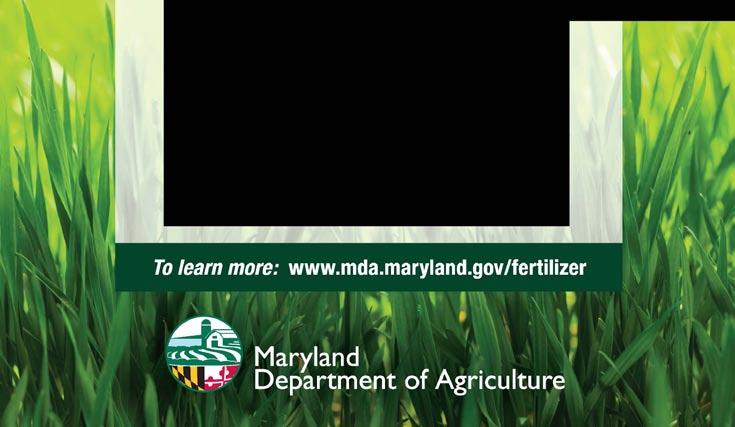


“Inspire. Connect. Grow.”
The National Garden Bureau is a nonprofit organization that exists to educate, inspire, and motivate people to increase the use of garden seed, plants, and products in homes, gardens, and workplaces by being the marketing arm of the gardening industry. Our members are experts in the field of horticulture and our information comes directly from these sources. Find out more at https://ngb.org/

‘Leaf’ Your Lawn Unraked This Fall
As cooler weather approaches, DMVarea lawns will soon be covered with fallen leaves. Many homeowners may feel pressure to rake, bag, and haul them away, but Mike Goatley, Virginia Cooperative Extension turfgrass Extension specialist, says there is a better option.
“People are right to be concerned about a thick layer of leaves covering their grass,” Goatley said. “If there are too many, leaves can block sunlight, shading the turf, and reducing growth. Leaves also trap and hold moisture, increasing the potential for turf disease.”
While some leaf maintenance is necessary, simply mulching leaves with a lawnmower and leaving them in place is an easy and environmentally friendly solution for most residential lawns. Learn more about “leaf” them alone leaf management in the “Leave Them Alone” Virginia Cooperative Extension publication at https://www.pubs.ext. vt.edu/430/430-521/430-521.html.
Here are a few tips for turf and leaf management.
• Use a rotary mower for leaf mulching, but not a stump grinder or chipper/ shredder.
• Inspect the area and remove sticks and limbs before mulching to reduce the chance that you or someone else could be hurt by flying debris.
• Wear safety goggles and an air mask over your mouth and nose to protect yourself from debris and dust.
• Mulching moist leaves minimizes dust concerns, but if leaves are too wet,
it increases the strain on your mower’s engine and does not chop the leaves into small pieces that easily decompose in the soil.
• Consider the limitations of the mower itself. Don’t try to mulch more than 6 inches of leaves at a time.
• While leaving leaves in place on turf may provide some nutrient benefit to a lawn, it is not a substitute for routine soil testing and proper fertilizer application.
“There have been numerous studies on the effect of leaf mulching for turf, and they show that the impact on turf is positive and economical,” he said. By rethinking traditional fall cleanup habits, homeowners can reduce yardwork stress, cut disposal costs, and help the environment. o
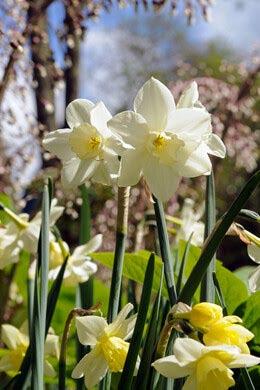
Daffodils: Plant Once & Enjoy Them For Years
Who doesn’t want an early spring full of color and life? Daffodils are the ultimate harbingers of the new season. Their brilliant yellow, white, or orange flowers bring instant sunshine to your garden, balcony, or terrace. Best of all, you only have to plant them once and they’ll come back every spring.
Daffodils (Narcissus) are a favorite spring flower because they’re lowmaintenance, grow effortlessly in almost any garden, and require little care. Plant them in the fall and enjoy a profusion of vibrant blooms for years.
Their versatility means that they do well in borders, lawns, pots, and window boxes. As an added bonus, deer and rabbits usually leave daffodils alone. Plant daffodils between September and November—before the first frost— because they need a cold period to flower in spring. Choose a sunny spot or one in light shade, with well-drained soil. Use large pots or containers with drainage holes and mix some sand into the potting soil. Plant the bulbs two to three times as deep as their height, with the tip facing up. After flowering, you can deadhead the blooms, but leave the leaves alone until they turn yellow: the bulbs will then store energy for the next year.
You can be creative when planting daffodils. For example, scatter the bulbs randomly over the lawn and plant them where they land for a natural look (do not mow the grass until the leaves have yellowed). In pots, you can combine different daffodil varieties to enjoy longer flowering times or mix them with other spring bloomers such as tulips (Tulipa) and grape hyacinths (Muscari). Smaller, compact daffodils such as ‘Tête-à-Tête’ are perfect for a balcony or patio. They take up little space yet provide plenty of joyful spring atmosphere.
Here are a few daffodils facts and planting tips.
• Remove weeds and small stones, and then work some compost into the soil to improve drainage.
• Place the flower bulbs gently into the soil with the point on top. Be careful not to press down too hard on the flower bulbs, because this could damage them. Large flower bulbs should be planted 3 to 8 inches apart and small bulbs 1 to 3 inches apart.
• Daffodils symbolize new beginnings and hope, which is most welcome after a long winter.
• There are thousands of varieties, from mini-daffodils to impressive trumpet daffodils.
• Daffodils are self-seeding and often return in greater numbers each year.
• Some daffodils have particularly lovely scents—especially the varieties with smaller flowers, such as jonquils (Narcissus jonquilla).
Find more information about flower bulbs at www.flowerbulbs.com. o
Photo courtesy of www.flowerbulbs.com.
A thick layer of leaves can block sunlight, shading the turf and reducing growth, but mulching leaves with a lawnmower and leaving them in place is an easy and environmentally friendly solution. Photo by Mike Goatley for Virginia Tech.

New Plant Spotlight
Stonecrop (Sedum spurium) ‘Rock Candy’ PPAF™
Sedum spurium ‘Rock Candy’ is a red, ground-hugging plant with a vigorous growth habit. Plants emerge with red foliage in spring. In midsummer, the plants bloom rose-pink. The short, clumping plants only reach around 3–4" tall and around 12" wide or more. It prefers a welldrained soil in full sun. The hardiness is USDA Zones 3–9.
It can it be planted in spring, summer, or fall. This new sedum combines nicely with other low-growing sedums like Sedum spurium ‘John Creech’ and ‘Leningrad White’. It is beneficial to pollinators and birds. It is also deer-resistant.
This plant was bred and introduced by Intrinsic Perennial Gardens, Inc. For more information, visit www. intrinsicperennialgardens.com. o
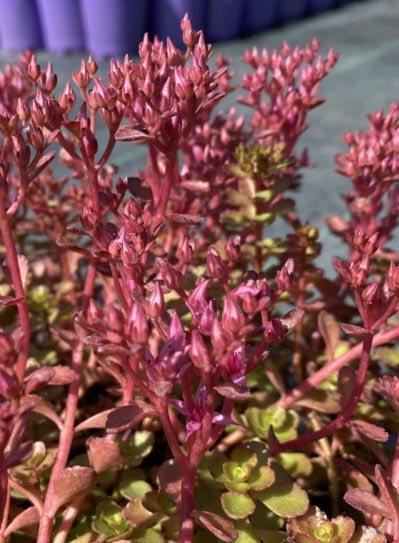
Quick Links to Recent Washington Gardener Blog Posts
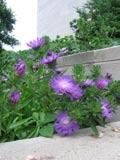
• Hairy Aster Plant Profile
• Carnivorous Plants
• Cowpeas Coming
See more Washington Gardener blog posts at WashingtonGardener.blogspot.com o
November Garden To-do List
• Switch your deer-deterrent spray if you’ve been using the same one for several months. Re-apply after heavy rains.
• Have your soil tested at least once every three years.
• Cover carrots and other root crops with straw to extend the harvest season.
• Deadhead spent mums and plant them if they are still in pots.
• Don’t panic about leaf/needle drop on established evergreen shrubs and rhododendrons. It is normal for them to shed a third at this time of year
• Bulb foliage already starting to surface? Don’t fret. It is also normal and will not affect next year’s blooms.
• Check for vole problems and set out traps.
• Caulk and seal your home to prevent wildlife from coming indoors.
• Protect fig trees from freezing by piling leaves around them.
• Clean the leaves of indoor houseplants to prevent dust and film build-up.
• Collect plant seeds for next year’s planting and trading.
• Turn off outdoor water valve and store hoses.
• Store terra cotta pots in a shed or protected area.
• Prune and mulch hybrid tea roses.
• Harvest the last of your vegetables and till compost into the beds.
• Plant garlic for harvest next spring.
• Force spring bulbs for indoor blooms this January by potting them up, watering thoroughly, and placing them in your vegetable crisper for about 10 weeks.
• Remove this year’s fruiting raspberry canes down to the ground.
• Clean out your ponds and compost annual plants. Move hardy plants to deeper water. Cover with netting to block falling leaves.
• Clean, sharpen, and store your garden tools.
• Reduce fertilizing of indoor plants (except cyclamen).
• Set up a humidifier for indoor plants, or at least place them in pebble trays.
• Vacuum up any ladybugs that come into the house and release outside.
• Rotate houseplants to promote even growth.
• Pot up Paperwhites and Amaryllis for holiday blooming.
• Water evergreens and new plantings to keep them hydrated this winter.
• Fertilize your lawn and re-seed if needed.
• Transplant trees and shrubs.
• Continue to divide and transplant perennials.
• Rake leaves, shred, and gather in compost piles.
• Start feeding birds to get them in the habit for winter.
• Attend a local garden club meeting.
• Turn your compost pile weekly and don’t let it dry out. Work compost into your planting beds.
• Plant evergreens for winter interest.
• Weed.
• Take a break from holiday stress to enjoy your garden.
• Do not place live wreaths or greenery between your door and a glass storm door, especially if the doorway is facing south. This placement will “cook” the arrangement on a sunny day.
• Sign up all your friends and family for garden magazine subscriptions as holiday gifts. o

The Urban Garden: 101 Ways to Grow Food and Beauty in the City is all about small-space gardening solutions!
By Kathy Jentz and Teresa Speight
Published by Cool Springs Press/Quarto Homes
Order it today at: https://amzn.to/3yiLPKU

GardenDC Podcast
The GardenDC podcast is all about gardening in the greater Washington, DC, and Mid-Atlantic area. The program is hosted by Kathy Jentz, editor of Washington Gardener Magazine, and features guest experts in local and national horticulture. The latest episodes include interviews with experts on Garden Design, Carnivorous Plants, and Poison Ivy. You can listen online at https:// washingtongardener.blogspot.com/ or on Spotify, Apple, etc o
Classes, Events, and Plant Shows/Sales
• Thursday, November 6, 10:30am— 12:30pm
Holiday Floral Design
Hosted by District III of the National Capital Area Garden Club at Christ Evangelical Lutheran Church in Fairfax, VA. Ticket required. See details at https://www.ncagardenclubs.org/districtiii.
• Saturday, November 8
Final Garden Workshop & Celebration
Learn about how to winterize your garden, dye fabric with indigo, enjoy a potluck and hot chocolate bar, and build connections with other gardeners at the Capital Area Food Bank garden in Washington, DC. For details and to register, visit capitalreafoodbank.org.
• Sunday, November 16, 12:30–1:30pm
$10
Significant Tree Lecture in the Renwick Chapel
Explore Oak Hill’s tree-scape, looking at the cemetery’s oldest trees in Georgetown, Washington, DC. Ecological historian Michael Gaige will discuss how to recognize them, identify different species, and what the cemetery may have looked like in the early 19th century. Register at oakhillcemeterydc.org.
• November 21, 2025, through January 11, 2026.
A Longwood Christmas
Wrap yourself up in the warmth—and the chill—of the holiday season at Longwood Gardens in Kennett Square, PA. Purchase timed tickets online at https://longwoodgardens.org/eventsperformances/longwood-christmas.
Opens Nov 21, 2025, and runs through January 4, 2026
Garden of Lights 2025
Garden of Lights returns to Brookside Gardens in Wheaton, MD. This year’s winter light display is a stroll through the half-mile outdoor, walk-through exhibit and enjoy the twinkling lights and glimmering one-of-a-kind dis-
plays. All tickets must be purchased in advance. Learn more and buy tickets at https://montgomeryparks.org/.
• Saturday, November 22, 1–2:30pm
Seasonal Holiday Plants and BulbForcing Demo
Join Kathy Jentz, editor and publisher of Washington Gardener Magazine, for a festive and informative workshop about caring for classic seasonal plants. She will share expert tips about nurturing holiday favorites and introduce a few unique plant varieties that make thoughtful gifts and charming additions to your home décor. You’ll also learn the basics of bulb-forcing. Register for the class and supply fee. $43 per person. Register online at http://www. fairfaxcounty.gov/parks/parktakes or call Green Spring Gardens at 703-6425173. Code TQL.DO6W.
Looking Ahead
• January 7–9, 2026, MidAtlantic Nursery Tradeshow
MANTS is one of the largest private trade shows serving the horticulture industry. Held at the Baltimore Convention Center in Baltimore, MD. Early-bird registration is now open at MANTS.com.
• Saturday, January 31
Washington Gardener Seed Exchange at Brookside Gardens
Details in our next issue.
• Saturday, February 7
Washington Gardener Seed Exchange at Green Spring Gardens
Details in our next issue.
Event Listing Updates
See updated event listings on the Washington Gardener discussion list. Join by emailing WashingtonGardenersubscribe@googlegroups.com.
How to Submit Events
To submit an event for this listing, email washingtongardenermagazine@gmail. com with “Event” in the subject line. Our next deadline is November 10 for the December 2025 issue, for events taking place after December 5 o
Ask the Expert
By Miri Talabac
White Bugs on Redbud
Q: Does my redbud have scale or mealybugs? I see white globs stuck on the bark, although the plant otherwise looks okay. What action should I take to protect the tree?
A: These objects have fooled me once before this time of year: I saw some on a redbud and initially thought it was a scale infestation, since they were clustered together and about the right size for certain scale species. In this case, while the objects do look very scale-like with their white coverings of wax, these are the egg masses of the Two-Marked Treehopper (or a very close relative). Rubbing the wax off the bark reveals a small linear slit underneath, which will not be present when scale are removed.
This small native insect looks like a curved plant thorn as an adult, presumably for camouflage, and the females insert eggs just underneath the bark or in stems on a variety of plants. The wax “plug” or cover atop this slit is probably for protection from predators, desiccation, or the weather. Over time, the wax will break down and disappear, and no action is needed since these insects are not known to cause serious damage to their hosts. My redbud had quite the population of treehopper egg masses a couple years ago, and it’s still growing well with no intervention.
Native Flower for a Sunny but Wet Garden Spot?
Q: I have a sunny area with wet soil where I’d like to include some more native perennials. I have species for early and midsummer blooms, but nothing for later. Do you have a suggestion?
A: I think Sneezeweed (Helenium) is underused and fits the bill nicely. Although its common name might make you think it’s a culprit of seasonal allergies, it is actually insectpollinated. (Plant respiratory allergens tend to come from wind-pollinated

species, like ragweeds.) Sometimes Helenium is called Helen’s Flower, which helps give people unfamiliar with this plant a better first impression.
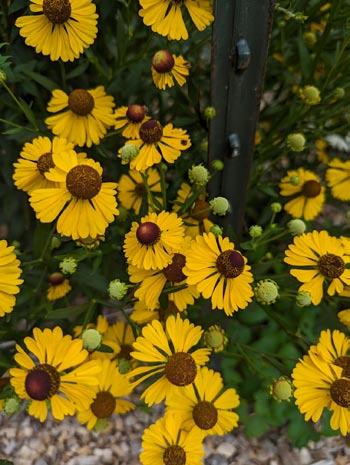
A denizen of wet meadows and sunny streambank habitats, Common Sneezeweed (Helenium autumnale) blooms late, with a peak in flowering around September, although it may still have a little color as late as the end of October. The subspecies autumnale is found across Maryland, as is the fellow damp-adapted species Purple-headed Sneezeweed (Helenium flexuosum), although its peak bloom is around midsummer instead.
As an aside, our third and scarcer local species, Narrow-leaved Sneezeweed (Helenium amarum ssp amarum), has a scattered distribution in Maryland’s coastal plain. Its native origin lies in the south-central U.S. As a summer annual, it has a comparatively long bloom season overall, which may provide a season extension into early autumn before a frost. However, it prefers drier conditions, so would not be a good direct substitute for H. autumnale or flexuosum.
There are multiple cultivars of Common Sneezeweed, and pollinators don’t seem to mind petal color changes. Wild specimens tend to be completely yellow, but multiple cultivated forms include orange or orange-red. Mt. Cuba Center, a native plant public garden in the piedmont of Delaware, published trial results for Helenium a few years ago, which gardeners may find of interest regarding plant performance, cultivation tips, and popularity with pollinators. See https://mtcubacenter. org/trials/helenium. o
Miri Talabac is a Certified Professional Horticulturist who joined the University of Maryland Extension Home and Garden Information Center in 2019 as a horticulture consultant. She is a graduate of UMCP with a focus in entomology. To ask a gardening or pest question, go to http:// extension.umd.edu/hgic and select “Ask Extension.” Digital photos can be attached.
Two-Marked Treehopper egg-laying sites. Photo by Miri Talabac.
A Garden-Friendly Native Orchid Spiranthes cernua odorata ‘Chadds Ford’
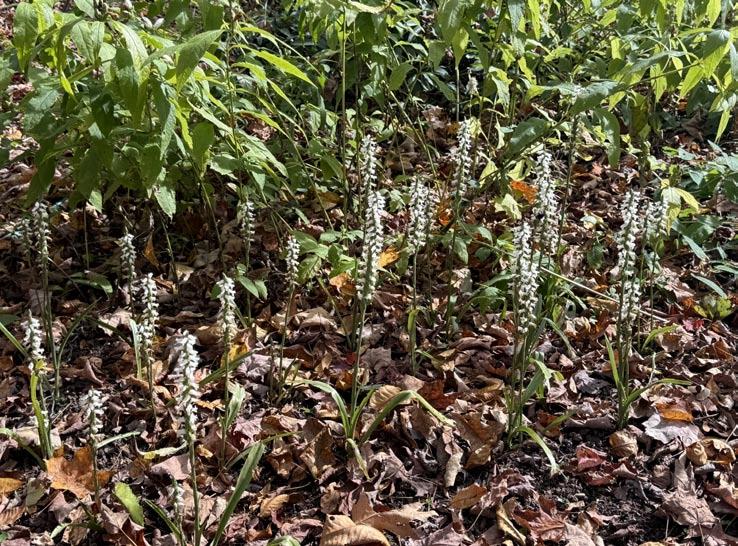
By Barry Glick
Like far too many native plants these days, Spiranthes cernua odorata ‘Chadds Ford’, a native orchid, was discovered just as its habitat was about to be destroyed. Dick Ryan, an eccentric character with a passion for native orchids, found the plant back in the 1960s in a wet ditch near his hometown of Bear, Delaware. At the time, Bear was a rural crossroads town. Today, this former orchid habitat is overrun by tract homes.
It didn’t take long for word about Ryan’s exquisite discovery to spread. Plantsman Dr. Merlin Brubacker was smitten by this denizen of temperate Delaware. In 1973, a division of the orchid grown by Brubacker received the coveted Certificate of Cultural Merit from the American Orchid Society.
Spiranthes cernua odorata, a fragrant form of the species commonly known as nodding ladies’ tresses, is found in coastal regions of southeastern states from Virginia to Florida and west to Texas, where it flowers from fall through winter.
Nodding ladies’ tresses grow to about 3 feet tall, with three to six glossy, darkgreen leaves up to 8 inches long on the lower part of the stem. Its yellowishwhite blossoms are larger than those of the species, Spiranthes cernua, which is found throughout eastern North America. Like other members of the genus Spiranthes, the flowers of
this species are arranged in a twisted, spiral-shaped spike. (The name Spiranthes comes from two Greek words: speira, meaning spiral, and anthos, meaning flower.) Members of the species are called nodding ladies’ tresses because of the nodding habit of the individual florets that make up the flower spike.
One of the most distinctive features of Spiranthes cernua odorata is its potent, sweet fragrance, often compared to that of vanilla or jasmine. ‘Chadds Ford’ is a wonderful cultivar—a vigorous grower with large, extremely fragrant flowers. Although the plant was discovered in Delaware, it was named in honor of Chadds Ford, the town in southeast Pennsylvania where Dr. Brubacker lived.
Ever since the dawn of gardening, orchids have had a mystique. In the words of botanist Welby R. Smith, who has written an entire book about the orchids of Minnesota alone, “Orchids are often thought of as rare, fragile objets d’art, existing only in steamy tropical forests or Edwardian greenhouses. In reality, nothing could be further from the truth. Orchids occur worldwide from the arctic tundra to Tierra del Fuego. They are absent only from the driest deserts and the wettest aquatic habitats.”
Orchids make up one of the largest plant families, with 725 genera
and more than 20,000 species, and account for some 7 to 10 percent of all flowering plants on Earth!
Nearly everyone is familiar with the multitude of orchids from the tropics, where the majority of orchids live. In most regions of this country, these must be grown as houseplants. Few gardeners are aware of the surprising diversity of terrestrial orchids native to the U.S. (As the name implies, terrestrial orchids are those rooted in soil. All orchids in temperate regions are terrestrial; most tropical orchids are epiphytic, meaning they grow on another plant but aren’t parasitic—usually in the canopies of the tallest trees.) Some 216 species of terrestrial orchids are native to North America.
Until recently, orchid lovers have only been able to appreciate native orchids in the wild, not in the garden. Many of these plants are slow to propagate and therefore are not readily available from commercial sources. For decades, orchids were dug up from the wild by unscrupulous collectors, who have decimated entire plant populations. This, in addition to loss of habitat to development, is the major threat to the long-term survival of many orchids, as well as other native species. For this reason, it’s important to buy native orchids only from nurseries that are propagating them vegetatively, not collecting them from the wild. Fortunately, in recent years, there have been great strides in propagating even the most difficult orchids, such as the lady slipper (Cypripedium reginae), which is being propagated by tissue culture by Bill Steele of Spangle Creek Labs in Washington.
Orchids are not only difficult to propagate; they also have a reputation of being almost impossible to grow. The most commonly accepted theory on why they’re so temperamental is that the symbiotic relationship with mycorrhizal fungi found on the root tips, essential for the breakdown of nutrients in the soil to forms the plants can use, is difficult to simulate in a garden setting. Spiranthes cernua odorata ‘Chadds Ford’ is the exception to the rule. It’s not only easy to grow, but also forms colonies quickly.
In August 1992, Dr. Richard Lighty, director of the Mt. Cuba Center for the
Study of Piedmont Flora in Greenville, Delaware, gave me a 6-inch pot of ‘Chadds Ford’. I kept the plant in a moderately heated greenhouse (45°F). By December 30 I was able to divide out 32 2½-inch pots and 18 4-inch pots, and put the stock plant back in its original pot.
The following spring, I transplanted several divisions outside in the garden. By midsummer, flower buds had begun to form. In late summer, my garden was graced with 18-inch spikes of waxywhite orchid flowers, tinged with green and scented like vanilla. The flowers persisted into late fall.
Like others of its species, ‘Chadds Ford’ prefers wet feet. However, it will do perfectly well in any rich, moistureretentive soil, in sun or shade. Given these conditions, this plant, which is stoloniferous, will multiply in no time at all. I highly recommend it, even for the novice gardener.
If you’d like to learn more about native orchids, take a look at the following books. Some are out of print but can be found in any good horticultural library:
• Hardy Orchids by Phillip Cribb & Christopher Bailes. Timber Press, Portland, 1989.
• Orchids for the Outdoor Garden by A.W. Darnell. First published by L. Reeve & Co., Ltd., Ashford, Kent, 1930. Reprinted by Dover Publications, New York, 1976.
• Wild Orchids of the Middle Atlantic States by Oscar W. Gupton and Fred C. Swope. University of Tennessee Press, Knoxville, 1986.
• Flora of West Virginia by P.D. Strasbaugh and Earl Core. Seneca Books, Morgantown, 1978.
• Orchids of Minnesota by Welby R. Smith. Univ. of Minnesota Press, Minneapolis, 1993. o
Barry Glick, a transplanted Philadelphian, has been residing in Greenbrier County, WV, since 1972. His mountaintop garden and nursery is a mecca for gardeners from virtually every country in the world. He writes and lectures extensively about native plants and Hellebores, his two main specialties, and welcomes visitors with advance notice. He can be reached at barry@sunfarm.com, www.sunfarm.com, or 304.497.2208.
Rhubarb

By Barbara Melera
Time is the greatest challenge for gardeners who wish to raise perennial root vegetables because it takes three years for an asparagus patch to mature, two years for a rhubarb patch to mature, and six months for a horseradish patch to mature. With this in mind, you need to get started now.
Rhubarb is an herbaceous perennial, a member of the buckwheat family. The plant possesses an extraordinary tolerance for both cold and drought. It is hardy down to USDA Zone 3 and can be grown in colder climates if mulched. It can adapt to warmer climates where the plants simply die back in summer and resume growth in the fall.
Rhubarb probably originated in the desert region of Siberia around the Volga River Basin. The name, rhubarb, comes from Rha, the name Muscovites gave to the river Volga, and barbarum, a reference to the barbarous people who lived in the region. Rhubarb is also known as “wild strawberry” and “pie plant.”
In 1770, Benjamin Franklin, who at the time was living in London, shipped a crate of rhubarb to Philadelphia to his friend, John Bartram, the preeminent American botanist of his time. It is generally agreed that 1770 was the year that rhubarb was introduced into the United States. It was not for another 60 years that the root gained popularity in the US. Some say this was because many folk associated the plant with “tincture of rhubarb,” a strong laxative that grandmothers might have forced on them.
There are three Rhubarb varieties commonly available today: Canada Red, Crimson Red, and Victoria. Canada
Red is perhaps the best variety. It is sweeter and redder than the other two, but extremely hard to find, and often Crimson Red is sold as Canada Red. Crimson Red, although less sweet than Canada Red, is a great rhubarb with large red stems. Victoria is the oldest variety. It first appeared in American seed catalogs in 1828. It must be harvested quickly because its red stems turn green within a few days and the plant tends to send up a flower stalk within a month of emerging from the soil, but the flavor is excellent.
Rhubarb lasts at least 20 years, so choose a place in the garden where it can remain permanently. To grow rhubarb from roots, plant them as soon as the soil is workable. In southern climates, fall planting is also practicable. Dig a series of holes that are 3 feet apart from center to center. Dig the holes 2 feet deep and 2 feet across. Line each hole with 6–8 inches of wellrotted cow manure and then begin to fill the holes with a mixture of equal parts compost and soil. Set the roots, one per hole, so the tops of the roots lie 3–4 inches below the surface of the soil and finish filling the hole with the soil-compost mixture. Mound the dirt about 2–3 inches above the soil’s surface as the dirt will settle with time and watering. Do not harvest the stalks during the first year. In the fall, mulch with decomposed cow manure.
In the spring, remove the mulch, and fertilize with a fertilizer high in nitrogen, then replace the mulch.
During the second year, harvest lightly by grasping the base of a stalk and pulling sharply. Do not cut stalks because large clumps left by cutting encourage disease.
Beginning in the third year, harvest only for about eight weeks. Immediately after harvesting a stalk cut off the leaves. The stalks will retain their moisture much longer. The roots need to be dug up and divided at least every five years to maximize the plant’s productivity o
Barbara Melera is president of Harvesting History (www.harvesting-history.com), a company that sells horticultural and agricultural products, largely of the heirloom variety, along with garden tools and equipment.
Running Out of Room? Get into Air Plants!
When I was first really getting into houseplants, I considered air plants boring. A plant that takes forever to grow? What’s the point? Now, as I run out of space on the shelves, I see the appeal. Heck, these plants don’t even need pots! You can nestle them between the branches of your larger plants, or hang them in a cute crochet hanger, held to the window with a suction cup hook.
I have an entire air plant section at my shop now (Easy Little Plants in Olney, near Rockville). You can get some of those adorable crochet air plant hangers, handmade by my friend, Dawn. The suction cup hook is included, too. You can buy air plants individually, but you also have the option to make an entire air plant terrarium in a shatterproof hanging orb, with a moon-shaped stand. You can add as many air plants, crystals, and animal figurines as you’d like.
I’ve been having a ton of fun with these plants, and in the process, I’ve learned the key to keeping them alive. First off, I have a little explaining to do. Like, what even are air plants? Air plants are members of the Tillandsia genus, which are native to warm parts of the Americas. They grow attached to all sorts of things: cliffs, cacti, tree branches, and telephone wires. That’s how they get their name. They don’t need or want any soil at all. They’d much rather hang out up in the air somewhere. It’s a good strategy—getting these unique plants closer to the sun than if they’d grown rooted to the ground.
Air plants absorb water and nutrients through their leaves. Roots only exist to anchor the plant onto whatever it’s using as a hammock. Air plants don’t hurt the trees they grow on. Instead, they coexist peacefully. There are somewhere between 650 and 660 species of Tillandsia, occasionally referred to, affectionately, as “tillies.” The largest air plant is the aptly named “giant air plant” which grows 3 feet wide, with a 6 foot tall flower stalk! Xerographica, another large air plant, which can eventually reach a similar width, takes eight years to grow 8 inches wide, when grown from seed.
Now, I was talking about saving space at the start of this, wasn’t I? Let’s talk smaller options. The commonly available Ionantha air plant generally only gets 2—3 inches tall, with the peanut variety, a specific type of Ionantha, only reaching a single inch in height. Neglecta is another small variety. It’s so small, in fact, that it sits comfortably in a thimble—what a cutie!
By Savannah Scollar

There’s a special trick involved for growing happy air plants. No, it’s not rainwater, a humidifier, a pebble tray, distilled water, or anything like that. It’s shaking your air plant like a maraca. After you’re done watering your air plant, it’s crucial to shake the heck out of it. Otherwise, water can stay trapped between the leaves, causing the plant to rot. I skipped shaking my air plants one or two times, and I definitely paid the price in casualties. Don’t forget it!
When it comes to watering, the only method I find practical is soaking my pants, sticking to a once-a-week schedule by having “Watering Wednesdays.” I put my air plants in one of my shop’s axolotl (aquatic salamander) aquariums and leave them for 20 minutes or more, while the axolotls look up in bewilderment. You can use any freshwater tank for this, regardless of what’s living there. If you don’t have a freshwater aquarium, you can use a random bowl or cup of tap water.
No, you don’t need to dechlorinate it or anything like that. I haven’t found any solid scientific evidence about chlorine actually harming these guys. Distilled water is a big nope, though, since it doesn’t have any nutrients. The aquarium method is convenient for me, since I don’t have to fill up a million cups to fit all of the air plants in the shop. It’s also great entertainment for axolotls or fish. Remember to do this once a week, and remember to shake, shake, shake. Let your air plant dry in a sunny spot before putting it into anything enclosed. There is the alternative watering option of thoroughly misting every side of your air plant every single day, followed by shaking, of course, but who would choose that over a simple weekly soak?
Never put a brightly colored air plant in an aquarium. These plants are dyed or spraypainted. On rare occasions, (right before
blooming,) an air plant may turn peach, purple-ish, or red, but you don’t want to risk any artificial colorant getting into your fish tank. This colorant can be messy in general, too: flaking off and leaving powdery residue. Not worth it! I’ll stick with the natural green, white, and silver. Air plant holders and decorations can provide some extra pops of color, if desired.
Watering your air plant and shaking it will serve as an easy indicator about whether your air plant is alive or not. If it falls apart when you shake it, it’s compost. If entire leaves look brown when they’re wet, they’re dead and can be removed. A brown base isn’t anything to worry about. Some air plants just look like that. Air plants with brown leaf tips can have their leaf tips cut back. These air plants are extra-thirsty and can benefit from longer soaks or some supplemental misting throughout the week.
Thin-leaved air plants can be annoying about that, needing more water than a regular, well-behaved air plant. I usually just stick to the plants whose leaves don’t look like the lead of a mechanical pencil. They’re much less demanding.
Bright indirect light means different things to different people, and is often cited as the correct lighting for an air plant. Basically, this means you should put your air plant somewhere within 5 feet of the window, but nowhere that gets super-hot. Imagine your window as a flashlight in the dark. Would something in the room be blocking the beam of light from getting to your plant? Is your plant too far away for a flashlight to reach it? Is the plant to the side, where the light wouldn’t hit it at all? It’s also important not to go overboard. You don’t want to put your air plant anywhere that the sun makes particularly hot. Plants can actually get sunburn and no amount of aloe will make it go away.
Don’t be scared to try something new. These easy-care plants start at only $3 each. Get yourself an air plant, get something cute to put it in, set up an alarm on your phone for “Watering Wednesdays,” and remember to shake your plant like a maraca.
Whether you want something emeraldgreen and smooth, or white and fuzzy, there’s a cute air plant out there, just waiting for you to bring home and nurture. o
Savannah Scollar opened Easy Little Plants (easylittleplants.com), a houseplant shop in Olney, MD, in July 2023. She loves doing research, teaching private workshops, decorating with houseplants, and arranging adorable terrariums
November 21, 2025, through January 4, 2026 (Closed November 24–27, December 24–25, January 1)
Brookside Gardens transforms into a magical winter wonderland for the annual Garden of Lights display. Stroll through the one-half mile, outdoor, walk through exhibit and enjoy the twinkling lights and glimmering one-of-a-kind displays adorning the flowerbeds and grounds throughout the 50 acre horticultural gem in Wheaton.
• Shop for unique seasonal items at the Gift Shop
• Hot chocolate and light snacks available for purchase
Tickets: Timed-entry tickets available at GardenofLights.org
• Sun - Thur: $13.99 per person (includes $1.99 service fee)
• Fri - Sat: $16.99 per person (includes $1.99 service fee)
• Ages 5 and under are free
• Visitors must arrive within their half-hour time slot
• Advance sale tickets only

BROOKSIDE GARDENS 1500 and 1800 Glenallan Avenue | Wheaton, Maryland 20902 301-962-1400 | BrooksideGardens.org
Burdock: Putting the “bur” in Velcro

By Rick Borchelt
It’s the sound of the modern world: that satisfying rrriiipp on your toddler’s no-lace shoes, the cinch on the cuff of your jacket as you secure it against the winds of winter, and the pocket flap of your quick-dry shirt. Velcro.
But before there was Velcro, there was burdock.
You may not recognize burdock right away, but your golden retriever does. It’s the plant that makes a royal mess of his hair, requiring endless combing or cutting or a trip to the groomers to remove the nickel-sized seed pods tangled irretrievably in his long coat. One 5-minute romp in a weedy field and he’s nothing but a tangled horror.
While burdock is an invasive biennial weed for us, folks have dealt with the hooked seed pods far longer than we have in parts of Europe where it’s native. Sometimes I can’t help but believe burdock is one of the reasons beagles and other short-haired breeds were invented.
It’s easy to imagine burdock reaching American shores in the tangled mane of a plowhorse or the pelts of a flock of sheep, but the reality is that burdock was probably introduced here purposefully, what with the deep taproot and
succulent leaf stems long popular with English cooks and apothecaries. They clearly deemed the hours spent cutting and combing burs off of dogs and livestock worth it for the medicinal and culinary value of burdock.
While all members of the burdock genus Arctium produce the namesake burs, the one we’re probably most familiar with in the Washington area is Arctium minus—known, as the Latin suggests, as lesser burdock or common burdock. Arctium lappa is the greater burdock, although size is relative to a casual observer, and it probably occurs more often than it’s given credit for. The undersides of the leaves of the much rarer woolly burdock (Arctium tomentosum) are densely covered in white down, whereas the lesser and greater burdocks have smoother, gray-green leaves. The stems of the basal leaves on lesser burdock are hollow, while the stems of greater burdock are solid.
All are in the aster family, and the pink (rarely white) flowers resemble miniature versions of those that grace their larger cousins, the thistles. For all practical purposes, the burs of all three burdocks are indistinguishable. Novice gardeners or botanists might
confuse the first year’s growth of this biennial plant with ornamental hostas, so lush is the foliage and so elegant are the leaves. I have, in fact, sometimes foolishly left a few plants growing in my garden for the almost tropical aspect of the 3-foot, vase-shaped, first-year clumps. I instantly regret it the next year when it blooms and sets seeds in those noxious burs.
The hundreds of hooks on each bur, which resemble diminutive crochet hooks, are an adaptation for seed dispersal. The flowering stalk reaches 4 to 6 feet high, just the right size to snag on a passing deer, fox, wolf, or bison—or nowadays, a passing dog, cow, or flannel-clad hiker. The seeds in the bur can thus travel miles before the unwary carrier gnaws or worries it out of its fur.
Burdocks are a resilient lot, and the seeds can lie dormant for years in the soil until they get the right amount of moisture, sunlight, and temperature to germinate. They are also difficult to pull up, owing to those long taproots, and any pieces left behind by the hand or the plow easily resprout.
This very resilience led naturalist John Burroughs to rail against burdock in his 1919 essay collection Field and Study:
A cluster of burdock burs hangs in wait for a passing furor flanner-bearer.
Photo by Rick Borchelt
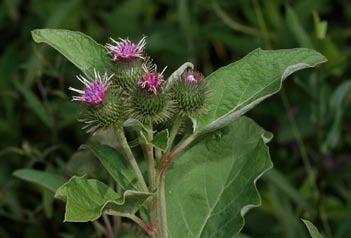
Closed Bottle Gentian
“Nature seems partial to the burdock. What extra pains she seems to have taken to perpetuate this worse than useless plant! Every man’s hand is against it, and nearly every animal has reason to detest it. Against their wills they are engaged in sowing its seeds.”
Swiss engineer George de Mestral begged to differ. As one origin story goes, on an evening in front of the fireplace, while combing burs out of his hunting dogs, his curiosity was piqued by how tenaciously the burs were able to hang on. When he examined the burs under a microscope, he observed their distinctive hook structure and wondered how it might be reproduced to make a fastener for cloth. After a number of unsuccessful attempts, in the 1950s, he hit on a fabric structure he patented and marketed as Velcro, a mashup of the French words velour (velvet) and crochet (hooks).
Foragers know that the stems on firstyear rosettes are edible, offering another common name of wild rhubarb. The stems are peeled and cooked just as rhubarb would be prepared. The root, if it’s to be used medicinally, should also be harvested in its first year.
Burdocks are not without wildlife value, either. While the leaves are bitter and seldom bothered by deer or rabbits (unlike your prize hostas), the flowers offer honeybees a source of nectar in late summer when few blooms persist; in winter, songbirds like goldfinches eat the seeds.
If, like me, you are loath to chop out the attractive foliage when it shows up in your garden, just remember to cut the flowering stalks down as soon as they are done blooming but before the burs form. Your dogs will thank you. o
Rick Borchelt is a science and natural history writer, field naturalist, and garden and botany enthusiast. Reach him with questions about this column at rborchelt@gmail. com.

By Kathy Jentz
It is a perennial wildflower with blue/purple blooms that are nearly closed at the tip. They are arranged in a tight clusters atop the stem and at full bloom, they look like they are buds about to open fully—although they never do. There are also some naturally occurring white versions of the flower.
Closed Bottle Gentian is hardy to USDA Zones 3–7. This plant is slowgrowing, but long-lived and very low-maintenance. It blooms from late summer into mid-fall and is not bothered by an early frost. It grows best in moist, rich soils, either in full or partial sun.
Bottle Gentian is pollinated by bumblebees that pry open the flower to crawl inside, sip nectar, and deposit pollen. o
Kathy Jentz is the editor of Washington Gardener.
Closed Bottle Gentian (Gentiana andrewsii) is native throughout the northeastern half of the United States.
The pink flowers of burdock resemble those of their larger cousins, the thistles.
Photo by Bill Hubick.

Start with Soil: Simple Steps for a Thriving Garden
Author: Juliet Sargeant
Publisher: Frances Lincoln
List Price: $22.00
Order Links: https://amzn.to/3WwHXnZ and https://bookshop.org/ a/79479/9780711289390
Reviewer: Andrea Siegel
Many of us gardeners have our eyes on what’s above ground, our bountiful harvest, wildlife in the habitat we created, and the lovely flowers and landscape. Or maybe we look at our gardens and wonder what went awry.
We should take a serious look at what’s beneath our feet, namely, the soil, says Juliet Sargeant, in her book Start with Soil: Simple Steps for a Thriving Garden, published this year in association with England’s Royal Botanic Gardens, Kew. Gardens are built from the ground up, and healthy soil is the foundation. Advocating for healthy soil, Sargeant writes that we should nurture it—it contributes to thriving gardens, more resilient plants, greater biodiversity, water filtration, healthier ecosystems and more. Our tracts of land are important in our local ecosystems; they’re also part of the world beyond our yards.
Sargeant packs a wealth of educational and practical information into 160 pages. She is a celebrated garden designer in the United Kingdom, and although the book is oriented toward there, it generally applies to the United States as well.
What makes Sargeant’s guide a different sort of gardening book is that it focuses on soil—everything in the book revolves around it. She writes about feeding the soil, not plants, because healthy soil will feed them. She gives readers an introductory science lesson about soil, teaching that it is complex, an underground kingdom with nutrients and living organisms, organic and inorganic matter, and so on.
Sargeant avoids heavy science jargon and puts explanations in context. The information is as accessible to a beginner as it is to a knowledgeable gardener who already may practice some of what Sargeant advises for fostering healthy soil.
The book moves logically from soil basics through showing readers how to learn about their soil (think: squeeze it, smell it, etc.), then on to gardening practices for better soil and what to grow for healthy soil.
Readers can learn how to feed the soil, including with homemade fertilizer (instructions included); why easy no-dig gardening is beneficial; and what different plants provide the soil in exchange for living in it.
Sargeant includes current topics, such as microplastics in soil and water, and changes in climate and weather, as they affect soil and plants.
Info boxes and photos are plentiful throughout. My favorite is a combination of the two—a simple test for assessing life in the soil. Spoiler alert: It involves planting your “pants.”
Of particular interest is the author’s chart of plants that are a good fit for various types of soil and why—a lesson in choosing the right plant for the right place and showing readers they can create healthy gardens no matter the soil type, even the Mid-Atlantic’s clay. Still, gardeners may wish to consult local plant lists.
The book is a solid guide and resource, and features step-by-step how-tos for most projects; some are quite simple. As usual, gardeners would do well to turn to specialized resources to learn more about the more complicated ones, and to assess the project and see if their skills match up. For example, the DIY gardener in the Washington, DC-area probably would
need more detail before digging into the local clay to build a rain garden. Although Sargeant offers a list of rain garden plants, local gardeners can seek lists that include area natives for plants closer to home.
Besides offering ways for giving soil well-deserved TLC, Sargeant’s book offers readers new appreciation of and knowledge about life and health underground. o
Andrea Siegel is a master gardener in Maryland.
The Chocolate Lover’s Garden
Authors: Sheri Ann Richerson and Tom Ogren
Publisher: Independently published List Price: $50.99
Order Link: https://amzn.to/3LbNfmt
Reviewer: Cavit Ireland
Sheri Ann Richerson and Tom Ogren’s book, The Chocolate Lover’s Garden, delivers decades of sweet-toothed imagination. It’s a horticultural Hershey’s kiss wrapped in research, passion, and dedication to creating a landscape that looks, smells, and tastes like chocolate.
Each chapter immerses the reader into a place where soil, smell, color, and texture become ingredients in a confectionery landscape. Like stepping through a doorway in Willy Wonka’s Chocolate Factory, a chocolate garden walks a fine line between fantasy and growing. It’s a sensory overload that offers a sweet sanctuary separate from traditional gardening styles. Backed by decades of experimentation, Richerson transformed her fascination with cacao into a gardening philosophy.
It all started with growing a cocoa tree in her Indiana living room, which proved to be difficult. Fast-forward through trial and error, and now Richerson’s curating a palette of chocolatey begonias and aromatic orchids, with her book as a translator for changing indulgence into action. The personal experiences of cultivating a tropical plant in a Midwestern grow tent acts as a symbol of perseverance.
“It smells like life in motion. Like resilience. Like home,” Richerson writes of the fragrant foliage.
Beyond cacao, the book dives into chocolate-themed plants that mimic

the characteristics of cocoa. Readers can learn about ‘Sharry Baby’ orchids that smell like candy, or the bronze leaves of the ‘Chocolate Ruffles’ species of coral bells. Richerson and Ogren balance giving practical design advice that is rich in senses, reminding gardeners of texture, color, and the harmonies they form.
However, the book doesn’t end at harvest. Richerson’s vision reaches beyond the garden into cultural significance, examining the history, evolution, and place that chocolate plants hold in society. In “The History of Chocolate: The Food of the Gods,” Richerson recounts the story of cacao from the sacred rituals of the ancient Maya and Aztec civilizations to its rise into a European royal luxury.
“It’s a way to reclaim the joy and wonder of chocolate while honoring its origins, respecting the hands that harvest it, and bringing a bit of that tropical decadence into your everyday life,” she writes about growing cacao.
Richerson hosts a gallery of “Famous Chocolate Lovers,” complete with presidents, scientists, kings, queens, and cooks showcased as chocolate connoisseurs. Through the eyes of visionaries and decorated gardeners, chocolate is recognized in its uniqueness as versatile, inventive, and aesthetically pleasing. Chocolate sheds the blanket of a guilty pleasure and arrives as a thread of joy for people throughout all walks of life.
Striking moments arrive with “The Darker Side of Chocolate,” with candid
commentary about child labor, deforestation, and the struggle of small farmers that illustrates the cost of cocoa. With this, she suggests the opportunity for conscious consumption that can prioritize ethics and sustainability.
The book is strong in its wide coverage of how a simple treat has taken many forms in society. Richerson writes with the curiosity of a newborn and the experience of an expert whose love for chocolate is invaluable. The Chocolate Lover’s Garden is a world built around chocolate, and an adventurous collection of creativity, gardening, and humanity all backed by tasteful love and joy. o
Cavit Ireland is an intern this fall semester with Washington Gardener. He is a rising senior at the University of Maryland studying journalism and hosts Sonic Fruit, a weekly music program on WMUC 90.5.
The Essential Guide to Bulbs: Grow a Bounty of Beautiful Bulbs in Gardens and Containers
Author: Jenny Rose Carey
Publisher: Timber Press
List Price: $29.99
Order Links: https://amzn.to/4hJS6Yg and https://bookshop.org/ a/79479/9781643263243
Reviewer: Teresa J. Speight
This book is an outstanding manual, loaded with information to empower gardeners to feel confident about growing bulbs in the ground or in containers. The mystery of growing bulbs is effectively explained by author Jenny Rose Carey. In her previous books, Carey deconstructs the necessary steps for successful gardening adventures with Glorious Shade and The Ultimate Flower Gardener’s Guide
This time, the focus is on bulbs. The author shares the botanical name, as well as the common name, growth requirements, and ways to use them in the garden.
Planning a bulb garden can be simple if you follow a few guidelines such as succession planting with the appropriate bulbs. A key component of this book is the alphabetical listing of bulbs by season. Even experienced gardeners need help in avoiding gaps in the garden year when blooms are sparse. Using the seasonal tips about what to

plant and when, Carey makes filling those gaps with bulbs quite simple. Using suggestions from this veteran gardener, adding bulbs in containers or in landscape design offers the reader the opportunity to create a personal touch where needed.
Understanding the dynamics of successfully growing bulbs in containers was one of my favorite chapters in this book. As I delve into creating moveable containers that capture seasonal beauty, it is refreshing to see how bulbs can add unexpected diversity to any container. Carey shares her perspectives on proper container selection, soils, correct planting depth, and more. All of these components are key to successful container bulb gardening.
Using photos from the author’s own Northview Garden in Ambler, PA, a list of resources, and essential tips, Carey has written another useful book that should a part of every gardener’s library. o
Teresa J. Speight is a native Washingtonian, mother, grandmother, steward of our land, and history lover. She is the author of Black Flora: Profiles of Inspiring Black Flower Farmers + Florists and co-author of The Urban Garden: 101 Ways to Grow Food and Beauty in the City
Note: The books for these reviews were provided free from their publishers. These book reviews include links to Amazon. com and BookShop.org for ordering them. Washington Gardener Magazine might receive a few cents from each order placed after you click on these links

The Writer’s Garden: How Gardens Inspired the World’s Great Authors
Author: Jackie Bennett
Publisher: Frances Lincoln
List Price: $40.00
Order Links: https://amzn.to/4oOC9SP and https://bookshop.org/ a/79479/9780711277168
Reviewer: Jim Dronenburg
This is a book for the literary gardener. It focuses on writers—not garden writers, like Gertrude Jekyll or Vita SackvilleWest (mentioned as a by-the-by in the part about Virginia Woolf), but about the gardens of famous writers, and how they influenced those authors. Some gardens are preserved; some are reconstructed. The 28 writers whose gardens are profiled range from Jane Austen to Louisa May Alcott, from Ernest Hemingway to Robert Burns. Each writer and their garden gets, on average, six to eight pages. There are great pictures of the gardens—and of the writers—and a wealth of biographical material about the writers. Remember, this is a book of how the writers were shaped by the gardens, not what they did in them or to them.
Your reviewer has not cared to go back and read the works of some of the writers featured. Some authors, like Karen Blixen and Antonio Fogazzaro, I’d never heard of; others, like Jean Cocteau and Roald Dahl, are known names but I have no impulse to go and read their works. I leave it up to the other people who take up this book to see if the points of view that the author shares about each writer are, in fact, valid.
That said, the text is well written; there is a lot of information here. Think of
nearly 30 biographies, boiled down to a few pages each and seen through a garden lens, in the same book.
In the back, there is a helpful section about visiting information for the gardens—and don’t think that you have to go to another continent; six of the gardens are in the U.S. The others are scattered through Great Britain, France, Germany, Denmark, Russia, and Mexico. There is also a half page of selected works by the authors, which bears perusal.
If your library doesn’t have this, it is well worth buying this book yourself “on spec,” assuming that you will find a new angle on one or more writers that you know. And you will know some of them, at the very least. o
Jim Dronenburg is a retired accountant and now gardens full-time in Knoxville, MD
Vibrant Harvest: Cultivating a Kaleidoscope of Colors in Your Vegetable Garden with Heirlooms, Modern Hybrids, and More
Author: Sandra Mao
Publisher: Cool Springs Press
Order Link: https://amzn.to/4hATADU and https://bookshop.org/ a/79479/9780760395110
List Price: $26.99
Reviewer: Ellen Isaacson
This fall, color isn’t just in the leaves; it’s sprouting right in your garden. In Vibrant Harvest, Sandra Mao reimagines the garden space, showcasing the vivid beauty of vegetables. Mao, who grew up around a garden as a young girl, brings a whimsical spirit back to vegetables. Mao fills this book with a rainbow of produce, incorporating colorful photos of various vegetables, and even a few flowers. She first introduces readers to the wide variety of colorful vegetables available. Included are lush images and graphics of Red Napa cabbage, Pink Celery, Rainbow Cauliflower, Purple Kale, and many more. One thing’s clear: When it comes to alternative vegetables, purple takes center stage.
The plants are organized by their growing seasons and the edible parts they offer, ranging from stem, leaf, bud, fruit, and pod to root. Mao provides in-depth profiles for each plant, teaching readers how to grow and care for them, and what to expect from their new, vibrant

vegetables. She encourages her readers to be in tune with themselves and emphasizes that the colors of your garden represent your energy.
Not only do colorful veggies liven up your garden and strengthen your connection to it, but different-colored vegetables also offer different health benefits, according to Mao.
For the more meticulous gardener, Mao includes detailed charts covering vegetable garden diseases, pests, and the seed-sowing process for your polychromatic plot. If you’re a visual learner, this book has everything you need; the lush images and thoughtful layout make it the perfect companion for both seasoned gardeners and beginners alike. Mao wants her readers to have flourishing gardens and to see the rainbow in their garden beds. She offers guidance about selecting the right type of garden, the right plants, tools, soil, etc.
Mao goes beyond the physical aspects of gardening, encouraging readers to consider its aesthetics as well. The more beauty you find in something, she suggests, the more you’ll want to nurture it, and a vegetable garden is no exception.
She closes the book in the only way that feels right: with tips for how to enjoy your bountiful harvest once the work is done. Mao shares a collection of recipes, along with step-by-step instructions for making delicious dishes. She explains the process of water bath canning and drying your vegetables, then offers some of her favorites, including chili oil, kimchi, and many more.
Her final message? Embrace the colorful nature of vegetables—they have more of an impact on our mood than we realize. o
Ellen Isaacson is an intern this fall semester with Washington Gardener



BACK ISSUE SALE!
YOU CAN REQUEST A SINGLE COPY OF PRINT BACK ISSUES FOR $6 EACH OR ANY 6 BACK ISSUES FOR $24, OR ALL 40+ PRINT BACK ISSUES FOR JUST $100. PRICE INCLUDES POSTAGE AND HANDLING. PLEASE SPECIFY THE ISSUE DATE(S). ORDER MUST BE PREPAID BY CHECK OR MONEY ORDER. SEND ORDERS TO: WASHINGTON GARDENER, 826 PHILADELPHIA AVE., SILVER SPRING, MD 20910
•
• Cherry
2005
• Stunning Plant Combinations
• Turning Clay into Rich Soil
• Wild Garlic
• Strawberries
JULY/AUGUST 2005
• Water Gardens
• Poison Ivy
• Disguising a Sloping Yard
• Kenilworth Aquatic Gardens
SEPTEMBER/OCTOBER 2005
• Container Gardens
• Clematis Vines
• Sponge Gardening/Rain Gardens
• 5 Insect Enemies of Gardeners
NOVEMBER/DECEMBER 2005
• Backyard Bird Habitats
• Hellebores
• Building a Coldframe
• Bulb Planting Basics
JANUARY/FEBRUARY 2006
• Garden Decor Principles
• Primroses
• Tasty Heirloom Veggies
• U.S. Botanic Garden
MARCH/APRIL 2006
• Top 10 Small Trees and Large Shrubs
• Azaleas
• Figs, Berries, & Persimmons
• Basic Pruning Principles
MAY/JUNE 2006
• Using Native Plants in Your Landscape
• Crabgrass
• Peppers
• Secret Sources for Free Plants
JULY/AUGUST 2006
• Hydrangeas
• Theme Gardens
• Agave
• Find Garden Space by Growing Up
SEPTEMBER/OCTOBER 2006
• Shade Gardening
• Hosta Care Guide
• Fig-growing Tips and Recipes
NOVEMBER/DECEMBER 2006
• Horticultural Careers
• Juniper Care Guide
• Winter Squash Growing Tips and Recipes
• Layer/Lasagna Gardening
JANUARY/FEBRUARY 2007
• Indoor Gardening
• Daphne Care Guide
• Asparagus Growing Tips and Recipes
• Houseplant Propagation
MARCH/APRIL 2007
• Stormwater Management
• Dogwood Selection & Care Guide
• Early Spring Vegetable Growing Tips
• Franciscan Monastery Bulb Gardens
MAY/JUNE 2007
• Roses: Easy Care Tips
• Native Roses & Heirloom Roses
• Edible Flowers
• How to Plant a Bare-root Rose
JULY/AUGUST 2007
• Groundcovers: Alternatives to Turfgrass
• How to Pinch, Prune, & Dead-head
• William Paca House & Gardens
• Hardy Geraniums
SEPTEMBER/OCTOBER 2007
• Succulents: Hardy to our Region
• Drought-Tolerant Natives
• Southern Vegetables
• Seed Saving Savvy Tips
NOVEMBER/DECEMBER 2007
• Gardening with Children
• Indoor Bulb-Forcing Basics
• National Museum of the American Indian
• Versatile Viburnums
JANUARY/FEBRUARY 2008
• Dealing with Deer
• Our Favorite Garden Tools
• Delightful Daffodils
MARCH/APRIL 2008
• Patio, Balcony, Rooftop Container Gardens
• Our Favorite Garden Tools
• Coral Bells (Heuchera)
MAY/JUNE 2008
• Growing Great Tomatoes
• Glamorous Gladiolus
• Seed-Starting Basics
SUMMER 2009
• Grow Grapes in the Mid- Atlantic
• Passionflowers
• Mulching Basics
• Growing Hops
FALL 2009
• Apples
• How to Save Tomato Seeds
• Persimmons
WINTER 2009
• Battling Garden Thugs
• How to Start Seeds Indoors
• Red Twig Dogwoods
• Unusual Edibles to Grow in Our Region
SPRING 2010
• Community Gardens
• Building a Raised Bed
• Dwar f Iris
• Broccoli
SUMMER 2010
• Fragrance Gardens
• Watering Without Waste
• Lavender
• Potatoes
FALL 2010
• Vines and Climbers
• Battling Stink Bugs
• Russian Sage
• Garlic
WINTER 2010
• Paths and Walkways
• Edgeworthia
• Kohlrabi
you trying to reach thousands of gardeners in the greater DC region/MidAtlantic area? Washington Gardener Magazine goes out in the middle of every month. Contact kathyjentz@gmail.com or call 301.588.6894 for ad rates (starting from $200). The ad deadline is the 10th of each month. Please submit your ad directly to: kathyjentz@gmail.com
Got a Garden Question?
Got a gardening question you need answered? Send your questions to KathyJentz@gmail. com and use the subject line “Q&A.”
Please also include your first name, last initial, and what city and state you are writing from. Then look for your answered questions in upcoming issues.
SOLDOUT!SOLDOUT!SOLDOUT!
SPRING 2011
• Cutting-Edge Gardens
• Final Frost Dates and When to Plant
• Bleeding Hearts
• Onions
• Flavorful Fruiting Natives
JULY/AUGUST 2008
• Landscaping with Ornamental Grasses
• Edible Grasses to Graze On
• Slug and Snail Control
• Sage Advice: Sun-Loving Salvias
SEPTEMBER/OCTOBER 2008
• Autumn Edibles — What to Plant Now
• Beguiling Barrenworts (Epimediums)
• Best Time to Plant Spring-blooming Bulbs
• 14 Dry Shade Plants Too Good to Overlook
NOVEMBER/DECEMBER 2008
• Outdoor Lighting Essentials
• How to Prune Fruiting Trees, Shrubs, Vines
• 5 Top Tips for Overwintering Tender Bulbs
• Harry Lauder’s Walking Stick
JANUARY/FEBRUARY 2009
• Compost Happens: Nature’s Free Fertilizer
• Managing Stormwater with a Rain Garden
• Visiting Virginia’s State Arboretum
• Grow Winter Hazel for Winter Color
MARCH/APRIL 2009
SUMMER 2011
• Ornamental Edibles
• Urban Foraging
• Amsonia/Arkansas Blue Star
• Growing Corn in the Mid-Atlantic
FALL 2011
• Herb Gardens
• Toad Lilies
• Sweet Potatoes
• Cool Weather Cover Crops
WINTER 2011/EARLY SPRING 2012
• Green Roofs and Walls
• Heaths and Heathers
• Radishes
SPRING 2012
• Pollinator Gardens
• Brunnera: Perennial of the Year
• Growing Yacon
SUMMER 2012
• Tropical Gardens
• Captivating Canna
• Icebox Watermelons
SPRING 2013
• Great Garden Soil
• All About Asters
• 40+ Free and Low-cost Local Garden Tips
• Spring Edibles Planting Guide
• Testing Your Soil for a Fresh Start
• Redbud Tree Selection and Care
SOLDOUT!SOLDOUT!SOLDOUT!
• Squash Vine Borer
SUMMER/FALL 2013
• Miniature/Faerie Gardens
• Beguiling Abelias
• Best Viewing Spots for Virginia Bluebells
MAY/JUNE 2009
• Top Easy Summer Annuals for DC Heat
• Salad Table Project
• Grow and Enjoy Eggplant
• How to Chuck a Woodchuck
• Growing Great Carrots
WINTER/EARLY SPRING 2014
• Ferns for the Mid-Atlantic
• Chanticleer Gardens
• Beet Growing Basics
Jentz Prints
Antique Botanical Prints for the decorator, collector, connoisseur, and art lover.
Jentz Prints can be purchased most weekends (weather-dependent) at the world-famous Eastern Market.

Antique prints are affordable—most in the $10-$30 range—and they are the perfect gift idea for that plant lover in your life. And don’t forget to buy a few for yourself! For more information or to get a detailed show schedule, please contact Jentz Prints by email at UllrichJ@aol.com.
